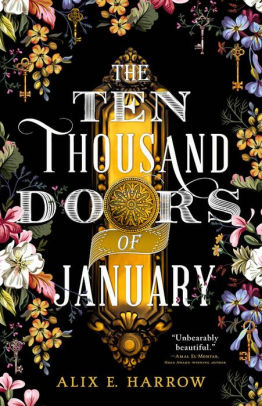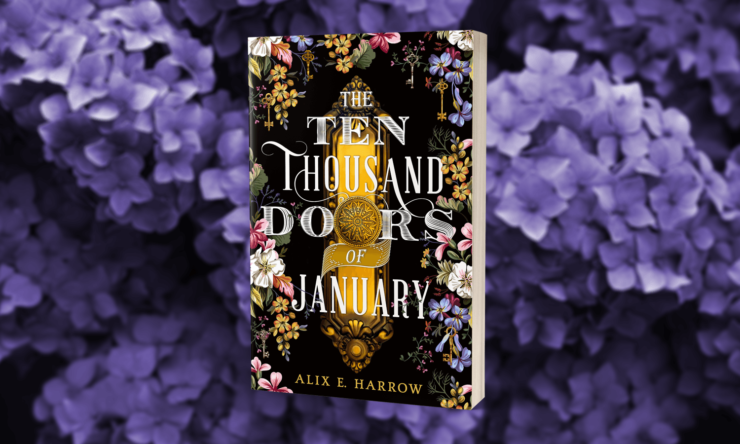January Scaller walks through a Door standing alone in a field and for a single moment enters another world—a chance encounter that will change the course of her life. While her father explores the globe, procuring treasures from far-off lands for his employer (and January’s foster-father of sorts) Mr. Locke, January learns to participate in high society, her willfulness crushed out of her one punishment at a time… until she happens upon a book: The Ten Thousand Doors. As the truth of her childhood experience begins to seem more and more real, she must question the world she lives in and her role within it.
The turn of the 20th century is a fraught, fruitful time to set a novel concerned with social change, gender, and colonialism. The Ten Thousand Doors of January occupies a world in transition, a precarious world, where institutional forces are in open conflict with resistance at all corners. January herself occupies several liminal spaces: she’s the ward of a wealthy white patriarch, and so able to access class privilege. However, she is also mixed-race, and so continually judged as to her fitness for given segregated spaces. All of her experiences are circumscribed by codes of gender and respectability, and a great deal of her struggle is against those codes.
Metafictional strategies in a novel often serve to distance the reader—because while you’re experiencing the story, you’re also operating at a remove that reminds you of the nature of the book as a book, referencing other books, commenting on the genre, pointing constantly to fictionality. And there’s a whole world of potential pleasure in that paradoxical distance! The reader is allowed to do critical work and consider the text’s arguments explicitly while also consuming a narrative with the related emotional delights. However, while The Ten Thousand Doors of January is certainly a book engaged with its bookness and with the whole genre of the portal fantasy (as well as a long history of feminist works in sf)… the underlying tender hopefulness Harrow imbues in January’s story, even in its moments of violence and exclusion, closes the gap of that metafictional remove.
Though the novel features a great deal of conflict, struggle, and trauma, it maintains a quite-purposeful softness toward the potentiality of the world and the work stories can do. For readers familiar with Harrow’s recent Hugo-winning short story “A Witch’s Guide to Escape: A Practical Compendium of Portal Fantasies” (which I discussed in brief, here), The Ten Thousand Doors of January has a similar argument built on similar frames. Stories have the power to change the world, or our individual lives, offering strategies of resistance to hegemonic oppression in the form of classism, racism, sexism, and so on. In both pieces stories have a wild, free sort of currency to alter the reality around them.
January just makes it literal, via the fantasy I think every single child who grew up to be a writer recognizes: didn’t we all hope, don’t we still hope, to be able to write words that literally alter the world? Nostalgia and optimism are strange bedfellows, since nostalgia often has a conservative bent toward an ideal past that never existed, but Harrow unites them here. The nostalgia is for childhood, for the cusp of adulthood, for moments where a person might crack through strictures and learn to change themselves or the world; the optimism is for the potential of the crack, the fracture, where the light comes in.
Buy the Book


The Ten Thousand Doors of January
That focus on the liminal also speaks to the novel’s place in a realm of readers—and market categories—because it certainly has that crossover appeal we hear so much about. The protagonist is seventeen and entering her adult life; the stories the book draws from, portal fantasies, are almost all children’s books. The potential that vibrates off the page is the potential of youth, of a certain form of imagination… but also present are the things elided from those earlier children’s stories, like ethnicity and class. Significant portions of the book, as it is set at the turn of the century, involve specifically gendered forms of oppressive violence: asylums, drugging and enforced stillness as “treatments” for hysterical behavior, women as chattel objects and women of ambiguous race in America moreso.
And yet, it isn’t grim. Harrow is, perhaps, more holding the reader’s hand with January through an exploration of hope in times of strife and crisis. The mix of optimism and nostalgia, the references to a whole genre of books, is a way of looking: here is the world, and it is raw, but we have the potential to change it. Part of where the novel retains its connection to children’s fiction is in the conclusion, which I found rather trimly neat and yet comforting. Comfort has a value, sometimes, even if critics often reject it. January earns her adulthood, regains her mother and father, and sets off to change the world(s) after a long, frightening struggle against a handful of individual men who represent the institutions of colonization and oppression. The metaphor of stories, power, and resistance is quite clear.
The Ten Thousand Doors of January is a liminal book. It’s all about doorways, and Doorways, and making the crossing between one place and another. It also sits on a threshold of audience given its prose and style, with the appeal of nostalgia to adults who need to remember the power of stories as well as young people who need to remember the heady potentiality of optimism—but then also vice versa, too, for all of us. An argument can be made from a place of tenderness and basic belief that, maybe, the world can be good. Harrow does that, gently, with an attention to real hurts but also a hope for healing them.
The Ten Thousand Doors of January is available from Redhook.
Lee Mandelo is a writer, critic, and editor whose primary fields of interest are speculative fiction and queer literature, especially when the two coincide. They have two books out, Beyond Binary: Genderqueer and Sexually Fluid Speculative Fiction and We Wuz Pushed: On Joanna Russ and Radical Truth-telling, and in the past have edited for publications like Strange Horizons Magazine. Other work has been featured in magazines such as Stone Telling, Clarkesworld, Apex, and Ideomancer.










